Saludos querida Comunidad de Hive | Greetings dear Hive Community
.png)
Esta semana traemos para ustedes un análisis de la obra Gymnopédie N°1 del compositor impresionista francés Erik Satie. | This week we bring you an analysis of the work Gymnopédie N°1 by the French composer Erik Satie.
Gymnopédie es el primer ciclo de tres piezas que escribe el compositor Erik Satie en el que evoca un mundo antiguo mediante el uso de recursos estilísticos de simplicidad absoluta, monotonía y armonías modales en donde se puede apreciar una clara influencia de parte del trabajo del compositor impresionista Claude Debussy. Sin embargo, el aporte más importante de Satie fue desarrollar un tipo de música que tuviera la capacidad interpretarse sin ser escuchada, y a su vez poseer un nivel de dificultad en la práctica para ser tomado como un estudio serio. A esta música el compositor le da el nombre de Música de mobiliario, o como lo conocemos hoy en día, música de fondo o de ambiente.
Gymnopédie is the first cycle of three pieces written by the composer Erik Satie in which he evokes an ancient world through the use of stylistic resources of absolute simplicity, monotony and modal harmonies in which one can appreciate a clear influence of some of the work of the impressionist composer Claude Debussy. However, Satie's most important contribution was to develop a type of music that could be performed without being listened to, and at the same time possess a level of difficulty in practice to be taken as a serious study. To this music the composer gave the name of furniture music, or as we know it today, background or mood music.
Cómo mencionamos anteriormente, Gymnopédie es un ciclo de tres piezas compuestas con recursos musicales similares, pero con un desarrollo y tratamiento armónico diferente, lo que les ofrece características únicas en su discurso musical.
As mentioned above, Gymnopédie is a cycle of three pieces composed with similar musical resources, but with a different harmonic development and treatment, which gives them unique characteristics in their musical discourse.
El carácter que indica el compositor es la partitura es Lent et douloureux, proporcionando un tiempo lento, pesado y constante. La obra cuenta con una distribución de tres planos sonoros, partiendo desde abajo hacia arriba, podemos notar los roles que emplea cada uno. El tercer plano, siendo uno de los primeros en aparecer, funciona como base de cada compás. Su figura, blanca con puntillo, aparece ininterrumpidamente desde el inicio hasta el fin. El segundo plano, no muy alejado de la función del tercero, tiene la tarea de crear estructuras armónicas que van cambiando poco a poco a medida que la pieza se desarrolla. Y por último, tenemos el primer plano que se encarga de exponer frases musicales variando entre las figuras de blanca con puntillo y negra.
The character indicated by the composer in the score is Lent et douloureux, providing a slow, heavy and constant tempo. The work has a distribution of three sound planes, starting from the bottom up, we can notice the roles that each one employs. The third plane, being one of the first to appear, functions as the base of each measure. Its figure, a dotted half note, appears uninterruptedly from the beginning to the end. The second plane, not far from the function of the third, has the task of creating harmonic structures that change little by little as the piece develops. And finally, we have the first plane that is in charge of exposing musical phrases varying between the figures of dotted half note and quarter note.

Para el periodo impresionista, las reglas estrictas que se ejercían en la música son dejadas de lado. Reglas como el movimiento de las voces, la jerarquía tonal y sus funciones no son de utilidad para la música de este estilo, ya que para este tiempo, los compositores empiezan con una búsqueda de nuevas sonoridades a través del uso de recursos musicales que anteriormente estaban prohibidos. Por ejemplo, la armonía que aquí se emplea es un tanto curiosa, ya que no se utiliza la armadura de clave para establecer un centro tonal, sino más bien como una guía a las alteraciones que se encuentran presentes en la partitura. En este caso, la armadura de clave nos indica un D mayor, pero el material utilizado en el primer acorde es de G mayor con séptima mayor y D mayor con séptima mayor en el siguiente compás. Desde el punto de vista funcional, se podría decir que el G mayor es el IV de D mayor, pero en realidad, el acorde de G no indica una tonalidad, sino más bien un modo, G Lidio. Estos acordes se exponen constantemente en el desarrollo de la Parte A, a excepción de sus últimos cinco compases en dónde la armonía realiza una cadena de tonalidades menores, a distancia de cuartas, siendo estos un punto de conexión entre la exposición y el desarrollo de la pieza.
For the impressionist period, the strict rules that were exercised in music are left aside. Rules such as the movement of voices, the tonal hierarchy and its functions are not useful for the music of this style, since by this time, composers begin with a search for new sonorities through the use of musical resources that were previously forbidden. For example, the harmony used here is somewhat curious, since the key signature is not used to establish a tonal center, but rather as a guide to the accidentals that are present in the score. In this case, the key signature indicates a D major, but the material used in the first chord is G major with a major seventh and D major with a major seventh in the following measure. From a functional point of view, one could say that the G major is the IV of D major, but in reality, the G chord does not indicate a key, but rather a mode, G Lidio. These chords are constantly exposed in the development of Part A, with the exception of its last five measures where the harmony makes a chain of minor keys, at a distance of fourths, being these a point of connection between the exposition and the development of the piece.
En la Parte B y en su re-exposición se realizan diversos cambios en el discurso musical. El primero es que el centro tonal cambia de G lidio a D dórico, dado que en el primer plano y en la armonía aparecen becuadros, convirtiendose en una sección llena de acordes menores, además que en el tercer plano cambia de ser la base armónica del compás a convertirse en un Ostinato que se mantiene en la nota D, pero oscilando en los acordes de E menor con séptima y novena y D menor con séptima y novena. Sin embargo, el cambio más evidente en esta sección se origina en los últimos ocho compases de la obra en donde el centro tonal se convierte en E frigio, producto a las alteraciones en el primer plano y el cambio repentino en el Ostinato a la nota E.
In Part B and in its re-exposition, several changes are made in the musical discourse. The first one is that the tonal center changes from G Lydian to D Dorian, given that in the first plane and in the harmony appear becuadros, becoming a section full of minor chords, in addition that in the third plane it changes from being the harmonic base of the measure to become an Ostinato that stays in the note D, but oscillating in the chords of E minor with seventh and ninth and D minor with seventh and ninth. However, the most evident change in this section originates in the last eight measures of the piece where the tonal center becomes E Phrygian, due to the alterations in the foreground and the sudden change in the Ostinato to the note E.
| Análisis estructural | Structural analysis |
|---|---|
| Los primeros cuatro compases le pertenecen a la Parte A. Estos dan una sensación de introducción dado a que estos primeros dos acordes tienen la finalidad de crear una atmósfera de somnolencia y melancolía que el compositor indica en el carácter de la obra. Este caso se vuelve a presentar en la re-exposición de esta misma sección en el compás cuarenta. | The first four measures belong to Part A. They give a sense of introduction since these first two chords are intended to create an atmosphere of somnolence and melancholy that the composer indicates in the character of the work. This case is presented again in the re-exposition of this same section in measure forty. |
| El cambio de los centros tonales indica el inicio de una nueva sección. | The change of tonal centers indicates the beginning of a new section. |
| La obra cuenta con unos compases que tienen sensación de cierre o de conexión, de las cuales pueden ser tomadas como puentes. | The work has some measures that have a sense of closure or connection, which can be taken as bridges. |
| En la Parte A se realiza un puente que sirve como un medio de conexión entre ambas secciones. En la Parte B ocurre la misma situación, las frases melódicas realizadas en el primer plano utilizan las alteraciones indicadas en la armadura de clave anunciando la llegada de la re-exposición de la Parte A. | In Part A there is a bridge that serves as a means of connection between the two sections. In Part B the same situation occurs, the melodic phrases realized in the foreground use the alterations indicated in the key signature announcing the arrival of the re-exposition of Part A. |
| Sin embargo, en la Parte B' ocurren variaciones en el discurso musical. El primero es el cambio del centro tonal a E frigio, evidenciandose en el Ostinato en el tercer plano. El segundo, en el movimiento por inversión de la frase melódica realizada en el primer plano. Y por último, el cierre de la obra con un acorde en D menor. | However, in Part B' variations occur in the musical discourse. The first is the change of the tonal center to E Phrygian, evidenced in the Ostinato in the third plane. The second, in the movement by inversion of the melodic phrase in the foreground. And finally, the closing of the work with a chord in D minor. |
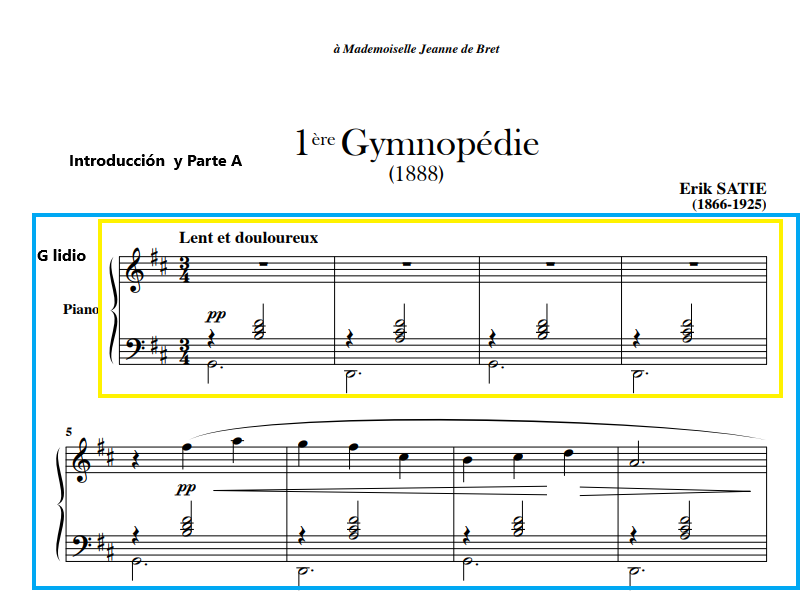
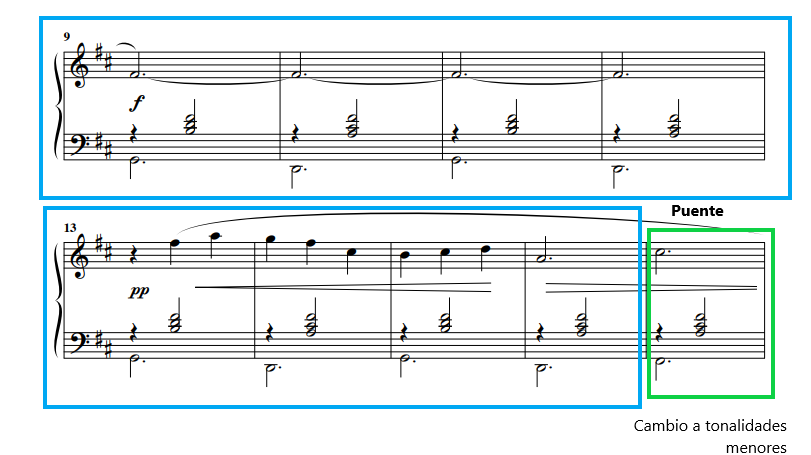
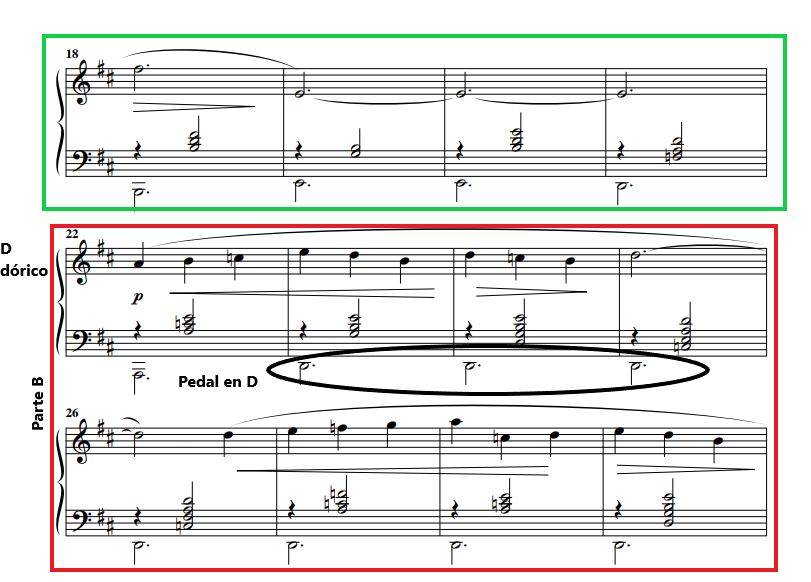
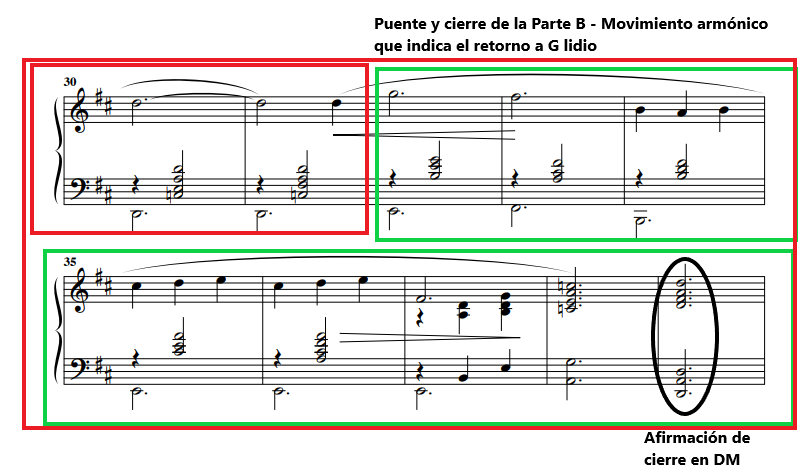
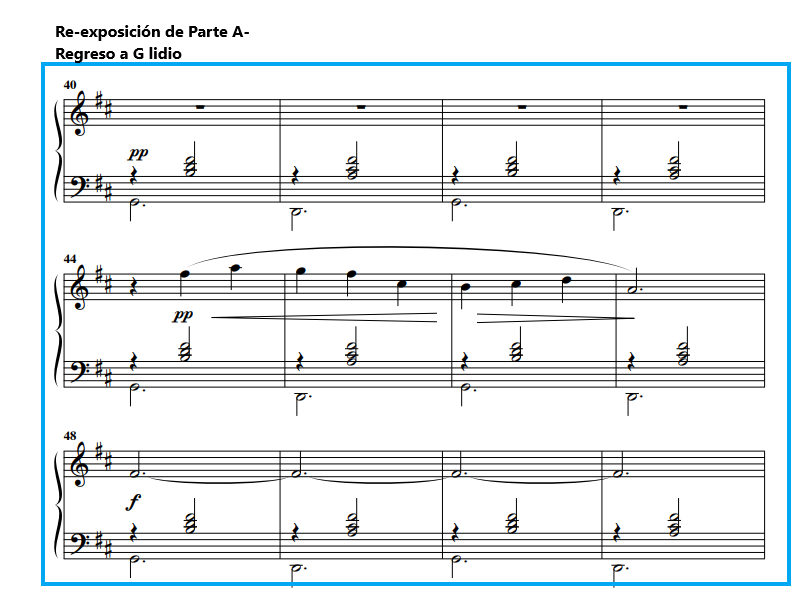
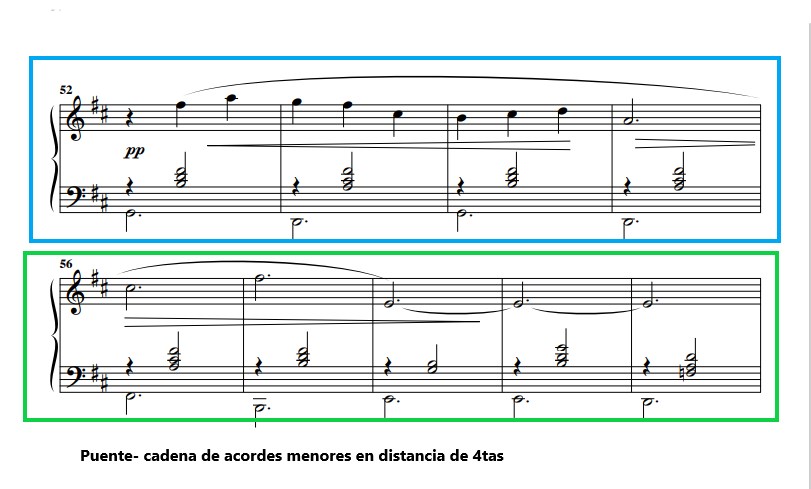
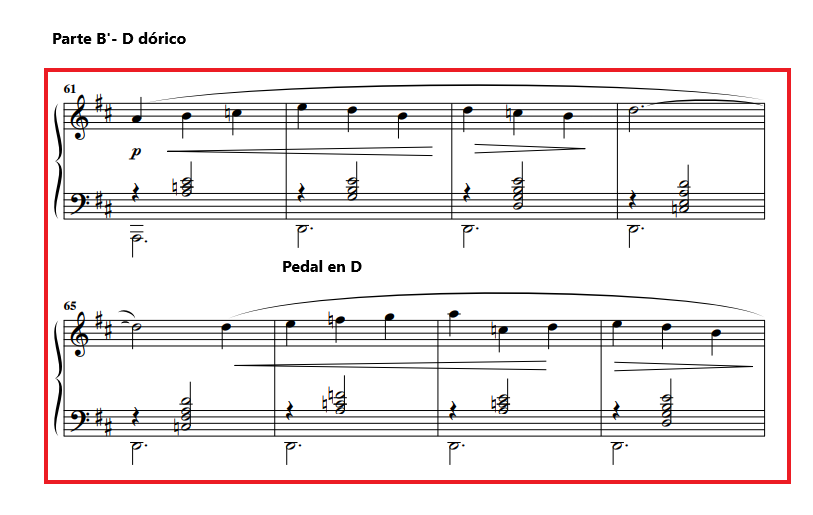
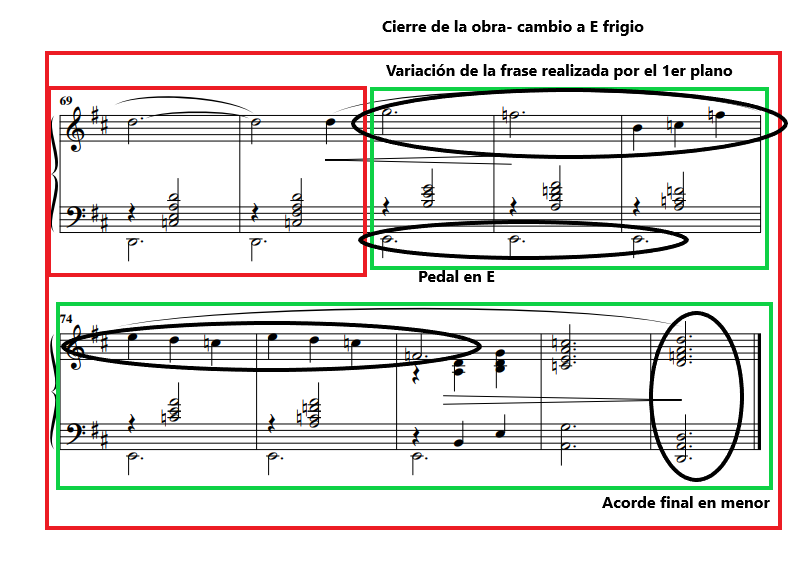
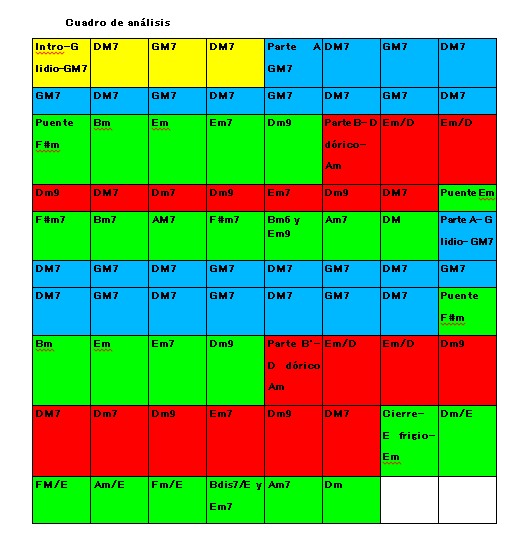
Esperamos que les haya gustado nuestro pequeño análisis musical de esta obra tan melancólica. Les dejaremos el enlace de dos videos que nos ayuda expandir la información ligada a Erik Satie y a Gymnopédie N°1. En el próximo artículo hablaremos un poco más sobre la magia de la música impresionista.
Paz y Música
We hope you enjoyed our little musical analysis of this melancholic work. We will leave you the link of two videos that help us to expand the information related to Erik Satie and Gymnopédie N°1. In the next article we will talk a little more about the magic of impressionist music.
Peace and Music
Fotografías tomadas de la partitura Gymnopédie N°1 de Erik Satie encontrada en imslp.org y editadas por @musicoda | Photographs taken from the score Gymnopédie N°1 by Erik Satie found on imslp.org and edited by @musicoda
Adjunto vídeo de la pieza analizada tomado de la plataforma Youtube| Artículo redactado por Gabriel Costa Imágenes realizadas por Gabriel Costa Artículo publicado por Musicoda | Article written by Gabriel Costa Images by Gabriel Costa Article published by Musicoda |
|---|
Bibliografía
- Satie E. (1888). Gymnopédie N°1
- Griffiths P. & Nichol .R (2008) Satie, Erick- Diccionario enciclopédico de la música. (pag.1337). México. Fondo nacional de cultura.
- Altozano J. (2020, 8, abril). La obra de piano más triste de la historia Gymnopédie N°1 de Satie. Youtube. Recuperado de: youtube.com/watch?v=_c0WOFgfXyc&t=632s
- Kilhamn H. (2019, 12,diciembre) Meandering music – Satie Gymnopédie no.1 – Análisis. Youtube. Recuperado de: youtube.com/watch?v=DrcRwu-ddqE

Congratulations @musicoda! You have completed the following achievement on the Hive blockchain and have been rewarded with new badge(s):
Your next target is to reach 3500 upvotes.
You can view your badges on your board and compare yourself to others in the Ranking
If you no longer want to receive notifications, reply to this comment with the word
STOPCheck out the last post from @hivebuzz:
Support the HiveBuzz project. Vote for our proposal!